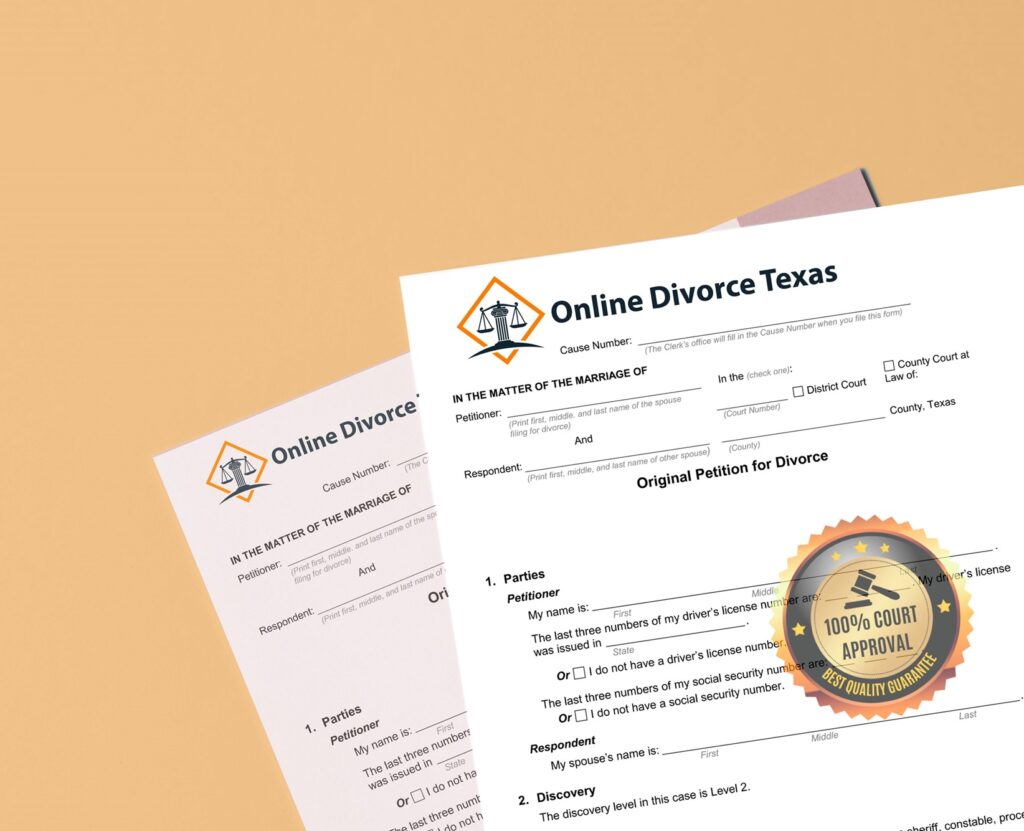The possibility of applying for uncontested marriage dissolution in Texas is usually affected by the couple’s unique circumstances. Most spouses wish to go through an uncontested divorce because it is typically simpler, quicker, and cheaper. However, often, such an amicable splitting isn’t an option for spouses. It happens when they can’t agree on some or all aspects of a divorce, be it child custody and support, property division, alimony, etc.
If you are faced with the prospect of a contested divorce in Texas, there are probably different questions bothering you. This article contains detailed answers to the most popular queries like how much a contested divorce in Texas costs, how long a litigation lasts, what possible challenges are, etc. By reading this information, you can get an idea of what awaits you and will be able to plan your further actions.
What Is a Contested Divorce in Texas?
A contested divorce in Texas means that parties cannot reach an agreement on the terms and details of the dissolution. The details usually center around child custody and parenting time, property division, and allocation of assets and finances.
This type of divorce is usually conflictual and time-consuming. Besides, when the divorce lasts for many months or even years, it emotionally drains all people involved. Since there are important legal issues to settle, spouses frequently address attorneys for help. Experts will represent them in court, take care of paperwork, provide legal advice, and more.
The complexities and expenses of a contested divorce may scare off some people, so they will eventually try to reach a consensus to qualify for an uncontested marriage dissolution. Those reluctant to compromise are likely to proceed with a contested case. Below, you can check out a comparison of uncontested and contested divorce procedures.

Uncontested vs. Contested Divorce
According to Texas family law, spouses can apply for a contested or uncontested divorce. The processes, potential expenses, and timeframes differ a lot, so it is worth considering them before initiating the divorce case.
| Aspect | Uncontested Divorce | Contested Divorce |
| Agreement | Spouses agree on all terms of a divorce, including assets and debt division, child custody and support, and spousal maintenance. | Spouses disagree on one or several aspects of a divorce. |
| Initiation | One spouse, called a petitioner, files papers with the court, or both spouses do it together and are referred to as co-petitioners. | One spouse files for divorce, initiating legal proceedings. |
| Process | It is simpler, faster, and more budget-friendly. | It often involves lengthy legal proceedings and negotiations, which prolong a divorce and increase costs. |
| Legal representation | Spouses may hire attorneys, but it is also possible for them to proceed on their own. | Each party typically hires a lawyer to navigate complex legal proceedings and have personal interests protected. |
| Duration | The average duration is 2-3 months. | It is hard to name the approximate duration as it depends on the complexity of the case and the number of conflicts. Usually, spouses have to wait 6+ months to get divorced. |
| Expenses | An uncontested divorce is generally several times cheaper than a contested one. Spouses need to cover filing and serving fees. If they have kids, they must also pay for parenting classes. On average, divorce cost can start at $500-$600. | The average cost of a contested divorce is $15,000. The number of conflicts and the involvement of legal assistants can greatly raise the price. |
| Final Decision | Since spouses have negotiated the terms of their divorce, they usually prepare a written settlement agreement with all crucial points clearly defined. In most cases, their decisions are approved by the judge and included in the Final Divorce Decree. | The court makes the final decision on the case after considering the evidence presented by both parties. |
What to Expect When You Contest a Divorce in Texas
“What happens in a contested divorce?” is one of the most frequently asked questions among people planning to go through litigation. The procedure is likely to be time-consuming and emotionally taxing if spouses aren’t willing to see each other’s point of view and collaborate. Generally, one of the most important stages is a contested divorce hearing, when both parties or their legal representatives need to present their claims and counterclaims.

The Process of Contested Divorce in Texas
The spouses typically need to go through a formal legal process involving document preparation, court hearings, and possibly a trial. Before starting the process, make sure you meet the residency requirements. According to the Texas Family Code § 6.301, either spouse must be a resident of the state for at least 6 months before filing. Besides, it is mandatory to live in the county where the case will be processed for no less than 90 days before submitting documents to the court.
Let’s focus on the entire process in detail, and you’ll see how to proceed if a contested divorce is inevitable in your situation.
Step 1. File Divorce Forms
A contested divorce procedure officially starts when a spouse initiating marriage dissolution files an Original Petition for Divorce and other documents in the local courthouse and pays a filing fee. The Petition includes personal information about the parties and their children, if any, the grounds for divorce and relief requested, such as child custody and support, alimony, and division of property and debts.
In Texas, it is possible to indicate in the Petition a specific partner’s wrongdoing as the reason for seeking marriage dissolution. The list of viable fault-based grounds includes cruelty, adultery, felony conviction, abandonment for at least 1 year, separate living for 3 years without cohabitation, and insanity with confinement in a mental hospital for at least 3 years.
A fault-based contested divorce can last very long, considering that spouses must collect supporting evidence. Not all partners are ready for such complexities, so no-fault marriage dissolution is more common.
Step 2. Serve Your Spouse
A petitioner must inform the other party about the initiated divorce case. To do that, it is necessary to serve a copy of an Original Petition for Divorce and Summons to a defendant. A petitioner cannot do it on their own. In the state, 2 main ways of delivering documents are in person or by certified mail with a return receipt requested by a constable, sheriff, or other person authorized by the court.
If you’ve made diligent efforts to locate your spouse but didn’t find them, you may request the court’s permission to serve them through posting or publication. Posting involves displaying a notice of the divorce suit at the courthouse, while publication entails printing a notice in a newspaper at specific time intervals.
If neither of the aforementioned methods is feasible, a petitioner can submit a Motion for Substituted Service to the court, affirming that traditional serving methods were unsuccessful.
Step 3. Wait for the Response
On average, a defendant has 20 days to prepare and file a response. The document may include counterclaims or requests for relief that differ from what is asked by a petitioner in the Original Petition. If a respondent doesn’t file an answer within the designated period, a petitioner can request a default judgment.
Step 4. Exchange Financial Information
Financial disclosure is an important stage of a divorce in Texas. Spouses have to share relevant information and documents related to assets, debts, income, expenses, and other pertinent matters. The court will use these details to make fair decisions on child support, property division, alimony, etc.
Step 5. Get Temporary Orders
In contested divorce cases, it is hard to predict when a Final Divorce Decree will be issued. Therefore, if either spouse wants to address pressing topics, e.g., child custody, visitation schedule, etc., they may request temporary orders on that issues from the court. These orders are legal resolutions that are valid till the judge signs the Final Divorce Decree. Spouses are obliged to follow the terms specified in temporary orders.
Step 6. Try Mediation
Some spouses may opt for mediation themselves, but it also happens that the court makes them attend mediation sessions. It is done to help the parties resolve debatable topics and eventually reach an agreement. While mediators can’t provide legal recommendations, they can facilitate communication, suggest efficient problem-solving techniques, and promote cooperation.
Step 7. Attend a Trial
If parties still can’t agree, they will have to participate in a trial. During the trial, spouses must present evidence, testimony, and arguments to the judge, who will decide on contested matters. After considering the information submitted, the judge issues a Final Divorce Decree. The document contains decisions on all disputes resolved as well as the rights and obligations of ex-spouses.
Step 8. File the Divorce Decree
Spouses must file the signed Divorce Decree with the clerk’s office so that their marriage is officially over.

How Long Does a Contested Divorce Take in Texas?
On average, a contested divorce in Texas lasts from 6 months to a couple of years. It is hard to say how much time a particular case will take, but you can consider the following factors for rough calculations:
- Complexity of issues. The more complex the issues involved, the longer the divorce process will last. Resolving complex matters may require extensive negotiations, discovery processes, and potentially multiple court hearings. For instance, a contested divorce with a child when parents argue about custody is likely to last longer than contested cases without kids and can even take several years.
- Mediation and settlement attempts. The length of mediation or settlement negotiations can affect the overall duration of a divorce process. Though mediation is extremely beneficial for resolving conflicts outside of court, unsuccessful attempts may prolong the proceedings, especially if the case ends up in a trial.
- Court caseload. The workload of a family court where the divorce is filed can also impact the timeline. Family courts often handle a high volume of cases, so your hearing and trial may not be scheduled as soon as you want. Besides, you need to complete a mandatory 60-day waiting period before the judge can review your case.
How Much Does a Contested Divorce Cost in Texas?
Similar to the timeline, the exact cost of a contested divorce in Texas is difficult to estimate, but the latest average numbers fluctuate from $15,000 to $20,000 and more. The price for legal assistance makes up the lion’s share of this hefty sum. Currently, experienced divorce attorneys charge $200-$400/hour. The main factors impacting an hourly rate are the reputation of a lawyer, their location, and the complexity of a case.
There are also court expenses to cover, namely, a filing fee, which is around $300-$350, and document serving payments of $50-$100, on average.
What Happens if You End up Able to Agree?
If parties manage to resolve disputes and come to an agreement on all terms of their divorce, they can convert a contested case into an uncontested one. They can file a joint petition, or one party may withdraw their claim to contest a divorce.
Moreover, a couple can create a settlement agreement outlining the preferred terms of property division, child custody and support, alimony, etc. This document must be submitted to the court for approval. Starting an uncontested case, parties can save money on legal assistance, avoid protracted legal battles, and get help with divorce paperwork from reliable online services.

Create your free account to see if you’re eligible to file for online divorce in Texas. Complete all paperwork from the comfort of your home, with no hidden fees.

